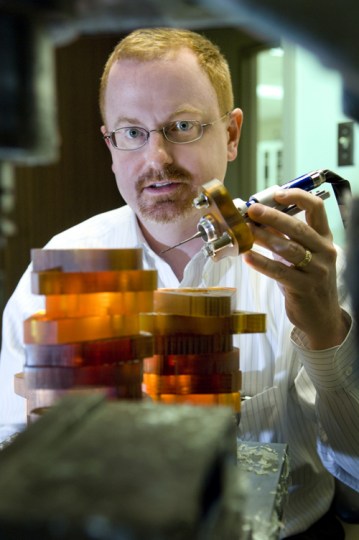
Robert Labadie, M.D., Ph.D., and colleagues are testing a new technique for cochlear implantation that uses a customized jig to guide the process. (photo by Susan Urmy)
New technique may improve cochlear implantation process
A new technique currently in testing at Vanderbilt Medical Center could make cochlear implantation faster, safer and less invasive.
If proven effective, the new technique could reduce surgery times from about two hours to as little as 20 minutes.
Called percutaneous cochlear implant, the technique uses a customized jig, known as a microtable, to guide a drill through the skull precisely to the cochlea to place an electrode that stimulates hearing. The current technique requires surgeons to manually drill a golf ball-sized hole behind the ear to perform the implant.
“We’re making a big hole to get to a tiny point, and we can’t just randomly pick a path. We would hit so many important things. So to accurately target the cochlea is extremely important,” said Robert Labadie, M.D., Ph.D., associate professor of Otolaryngology-Head and Neck Surgery and Bioengineering, and pioneer of the percutaneous cochlear implant.
One of the most serious complications of cochlear implants is damaging the facial nerve, which controls movements like eye blinking and chewing.
“The facial nerves lie right in the middle of the surgical field, so it is a very real possibility that they can be hit. Most people cite this happening in one in 500-1,000 cases using the traditional technique, but we feel very good about the statistics for our technique and think it’s probably better than that,” Labadie said.
The first step in percutaneous cochlear implantation is installing three metal screws that act as markers in a triangle behind the patient’s ear. This creates a consistent reference point to the cochlea. A portable CT scanner records the precise locations of the markers, and then a computer identifies the vital anatomy, predicts the best path for the drill and instructs the machine that makes the microtable.
To create the microtable, the machine drills three holes that will fit precisely onto the metal markers in the skull like a ball-and-socket joint and hold the jig in place. It also creates a hole in the middle of the microtable for the drill to glide through on its course to the cochlea.
There is precedence for using drill guides in deep brain stimulation, but those jigs often take more than 48 hours to construct. The microtable can be made in five minutes.
Labadie worked with J. Michael Fitzpatrick, Ph.D., professor of Computer Science and Engineering, to develop the microtable. They performed a cadaver study to test the technique, and then began clinical trials in 2007 with funding from the National Institute of Deafness and Communicative Disorders, part of the National Institutes of Health.
Co-investigator Benoit Dawant, Ph.D., professor of Electrical and Computer Engineering, directed efforts on automated path planning, allowing a computer to identify anatomy and predict the best path to the cochlea.
Labadie is currently testing the technique by performing a traditional cochlear implant, then fitting the microtable and verifying that the drill takes the correct path to the cochlea.
“We have now tested 19 ears and have a very high level of confidence that we’re not going to hit any vital structures. Probably in early 2010 we’ll actually do the full procedure,” he said.
“We keep looking for a criticism that is a fatal flaw, and we haven’t heard one yet. What we think is going to be the challenge is to prove that this is just as good as the other technique, and the other technique has good outcomes here in America,” Labadie said.
In addition to a significantly reduced surgery time, percutaneous cochlear implantation could also streamline delivery. After the traditional procedure is performed, patients wait three weeks before the implant is activated. With the percutaneous cochlear implant, there is the possibility to use local anesthesia, activate the implant on the operating table, and take the patient’s feedback to make more precise adjustments.
The research is generating significant interest worldwide. Labadie will present the findings at the 142nd meeting of the American Otological Society and will lead surgical discussions on the topic at the Cochlear Implant Conference in Seattle and the International Conference on Computer Aided Surgery around the Head in Paris.













